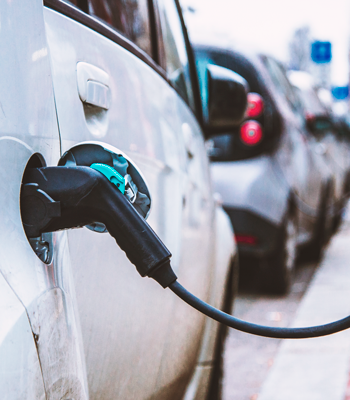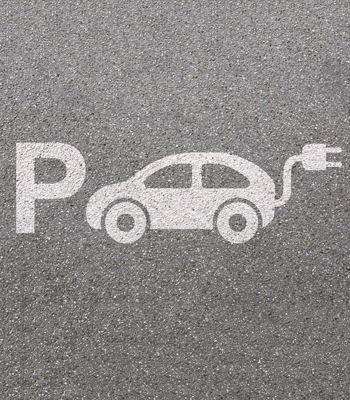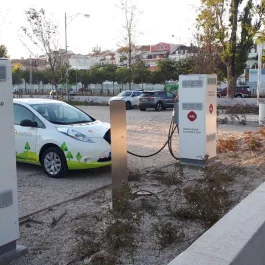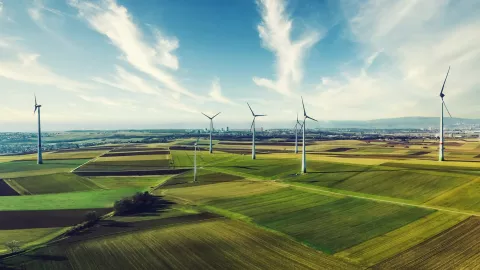How electric vehicles can boost the adoption of renewable energy and advance the decarbonization of the economy.
Electric mobility has seen rapid growth worldwide, a trend which is expected to continue in the next 5 to 10 years due to the gradual reduction in the cost of batteries and society's interest in this process.
The International Energy Agency estimates that there will be over 56 million electric vehicles in 2030, a number in line with the goals set at the Conference of the Parties (COP 21) in December 2015 in Paris: keeping the planet's average temperature increase below 2°C compared to pre-industrial levels.
The widespread adoption of electric vehicles can contribute, on the one hand, to reducing greenhouse gas emissions and, on the other, to optimizing the use of electricity produced from renewable sources in our everyday life.
Transportation is one of the most polluting factors
In Europe, the transport industry was the only major sector to increase its CO2 emissions since 1990. Transport in general accounts for 25% of CO2 emissions in Europe; road transport is the most polluting mode, accounting for 19% of total emissions.
A significant part of these emissions is caused by the increase in car trips in and out of urban centers. In fact, public transport is not considered comfortable or reliable enough to abandon the use of the car, even in the world's most developed cities. In Lisbon, average commute times in peak traffic hours are 61% higher than in normal periods - a score above the European average, and exceeded only by London, Paris and Rome.
Achieving the Paris Agreement targets requires a joint effort between citizens, governments and companies in the shift towards decarbonization. And it has become clear that this process goes hand in hand with electrification. In all sectors (including transport), the greater the use of electricity, the greater the potential for renewable energies and for abandoning fossil fuels.


Getting a new car? Go electric.
Countries across the world are moving towards decarbonization. Greenhouse gas emissions are expected to drop by 80% until 2050, propelled by the expansion of energy production from renewable sources.
And diesel vehicles seem to be among the first targets in this fight for the planet. Cities such as Madrid and Paris have already announced that no combustion engines will be allowed in the city center by 2025, and the sale of new combustion vehicles will even be banned in 2040. London, on the other hand, will charge a daily £10 fee from those who want to bring non-hybrid vehicles (at least) into the city center.
These figures may be daunting for those who have recently bought a diesel car, thinking that an electric vehicle is not a worthwhile investment as far as immediate savings are concerned. But we may be facing a scenario in which, five years from now, we will not be allowed to drive diesel cars in city centers without engine adjustments.
In fact, it is estimated that the turning point regarding the savings provided by gasoline and electric vehicles will take place around 2022 - from then on it will be officially cheaper to drive electric vehicles. Electric vehicle sales are expected to exceed fuel vehicle sales in 2035.


Electric and automated public transport
Outright decarbonization of a city's transport network requires the collaboration of several players, such as city councils or energy suppliers. Boston and Paris are good examples of how governments can build partnerships with companies in order to create a cleaner and more inclusive mobility model for all citizens.
Together with the World Economic Forum, Boston is implementing a fully autonomous electric vehicle network to complement the city's mobility system.
Paris, on the other hand, has developed a mobility ecosystem called Mobility Nation; bringing public and private organizations together, the system was designed to foster innovation in this field.
Optimizing renewable energies
One of the least known advantages of adopting electric mobility is that it can contribute to optimizing the use of renewable energies. Sometimes, the energy produced from these sources - most notably solar and wind energy - cannot be fully exploited because there is not enough consumption. As such, the grid becomes saturated with energy, which forces operators to limit production levels - precisely what we want to avoid, as the goal is to optimize the use of clean energy sources.
The growing adoption of electric vehicles can help solve this problem - whether locally, by using smart solutions to accelerate the consumption of electric vehicle chargers during peak sun periods; or globally, as many electric vehicles are charged up at night, when there is less consumption and more wind power, thus avoiding the waste of renewable resources.
Car charging habits have an impact, of course, and will bring new challenges to the way the power grid is organized, as there will be greater demand peaks, particularly at the end of the day.


90% of electric vehicle charges in Portugal take place at home or at work. The remaining 10% are carried out in public places such as shopping centers, car parks, or fast charging stations.
Impacts on the power grid
Low-voltage networks in urban areas are more likely to be affected by these changes in consumption habits. Currently, an average urban residential area with about 250 households is supplied by a 250kVA substation, having a peak consumption of 180kVA between 6 pm and 11 pm.
If we add to these consumption habits the charging of 60 electric vehicles at night, we will see a consumption peak twice as large, with a demand on the grid of about 360kVA during the same period. In practice, this would imply the need to quadruple the installed capacity of the substation in order to ensure seamless electricity delivery.
So how can we work around this issue, which could entail greater costs and the use of non-renewable energies? The answer is to implement Smart Charging and Vehicle-to-Grid solutions.
Smart Charging, as the name implies, is a smart charging method. It means having a vehicle charging process capable of meeting 'on demand' charging needs and of minimizing simultaneity with household appliances and other charging processes. Associated costs are therefore minimized.
On the other hand, Vehicle-to-Grid is the process whereby vehicles give energy back to the grid, thus contributing to optimizing the exploitation of renewable energies. For instance, with the increase in renewable wind capacity, electricity production at night is often higher than demand. With the adoption of Vehicle-to-Grid strategies, electric vehicles will be able to power up at night and give back stored energy to the grid when they are parked during peak demand periods. This ensures optimum use of wind power while also freeing the grid from the need to resort to non-renewable energy inputs.
For this reason, widespread adoption of electric mobility may contribute to a more efficient network management system, encourage energy microproduction, and absorb more electricity produced from renewable energies.
Electric mobility at EDP
Electric mobility is one of our strategic goals, as part of our commitment to sustainability and as an effective approach to tackle climate change. Therefore, we want to spearhead the transition to sustainable mobility and transport electrification.
To allow customers to charge their vehicles at home, we have launched Wallbox for condos in Portugal and Spain, domestic consumers in Spain and Brazil, and corporate customers in Brazil.

